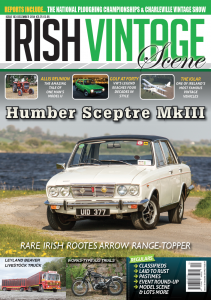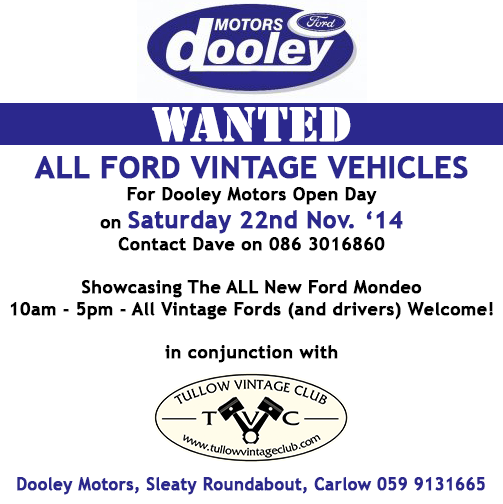
Filed Under: News with 0 Comments
OUR NEXT CLUB MEETING, THE LAST OF THE YEAR WILL BE ON TUESDAY THE 9th OF DECEMBER IN DANESFORT HALL AT 8.30.
WE WILL BE HAVING A MONSTER RAFFLE AND WILL BE HANDING OVER A FEW BOB TO THE CARLOW\KILKENNY HOME CARE TEAM THAT WE RAISED EARLIER THIS YEAR ON OUR CHARITY RUN
SO COME ALONG FOR A CHAT AND A FEW MINCE PIES……………….
Filed Under: News with 0 Comments
Filed Under: News with 0 Comments

Filed Under: News with 0 Comments
Sunday 30th November 2014
in The Carlton Hotel, Old Airport, Cloghran, Co. Dublin
From 10:30am to 3:30pm
Presented by: Brian Collins.
All enquiries to: 087 9827712
www.briancollinsenterprises.ie

Filed Under: News with 0 Comments
In his highly articulate, informative and interesting new book, ‘Putting Ireland on Four Wheels, A History of Irish Transport’, Wexford’s Austin O’Sullivan, known for his good works at the Irish Agricultural Museum, has turned to his other love for inspiration, anything with wheels.
Not that the book is restricted to wheels because Austin includes in its 400-plus pages reports of all forms of two- and four-legged modes of conveyance and tells how the 1798 Rebellion spurred the British government to develop our roads system to facilitate the fast transport of troops. In fact Austin makes the point that the (unusually straight) Newline Road between Wexford and the fort at Duncannon had just such a military purpose.
Port and boats, steam power, the railways and bycycles and motorcycles, of which he is an avid collector, and life before the establishment of the motor car all come under his detailed scrutiny.
‘For as long as the routes of communication between human settlements were only narrow, windind animal tracks, the movement of people and goods had to be on a small, local scale.. the more fortunate might have a donkey or a pony,’ says the author.
The next transition was to carts that could carry significant loads, with a Clydesdale able to haul a 2,000 pound load for 20 miles.
‘It was the immediate predecessor to the steam traction engine and the motor lorry for hauling heavy, bulky goods like hay, straw, grain. building materials and coal. Without motorised vehicles and proper roads, the movement of people and goods remained slow and localised.’
Within a few short years all this had changed, with the Rosslare Strand speed tests showing the dizzying speed of change.
Austin tells us that the Motor Car Act of 1903 was the first many later acts which would be used to generate funds for county councils, not always successfully.
‘At this moment, up to 70 per cent of the price paid at the petrol pump goes into State coffers. Likewise, only about 25 per cent of the annual road road tax paid by motorists paid by motorists actually gets spent on road works,’ he says. Don’t we know it!
Back on Rosslare Strand in 1913, Austin says that the newness of the (motor) sport was much in evidence by the innocence of both the police and the public in crowding in on the track.
‘It did not go un-noticed either that the police were more forthright in ordering the casual local visitors back than the well-dressed motorists (i.e. gentry). One policeman was injured when he stepped off a moving car and another had to be dissuaded from using the bonnet of a car to strike a match for his tobacco pipe’.
A few years earlier, in 1904 and early 1905, there were only 29 cars and 61 motorcycles registered in the county. In a social commentary of the times, only one was registered to a woman, an Olive Maud Meadows, of Ballyrane, Killinick; by 1908 there were 62 cars and 79 motorcycles. This rises to 177 cars and 124 motorcycles by 1916 and to 464 cars and 298 motorcycles in 1924.
With the advent and increase in the numbers of cars and motorcycles, came the first accidents which became a regular feature of the newspapers of the day, then as now.
A report in the Enniscorthy Guardian of May 30, 1908, describes how a local cyclist Andre Carton was killed on the Gorey to Enniscorthy road when his bicycle was in collision with a Welsh tyre magnate’s car.
It was difficult from the report in the paper to find the cause of the accident, but a witness stated: ‘the car was driving at a terrible rate and it was hopping up and down the road’.
Passenger Herbert George Davis said he always carried a police whistle when motoring in case the horn became defective. He always blew it at every crossing and bend in the road.
The People newspaper of July 12, 1913, reported one of an increasing number of road accidents that were appearing.
It stated that a car belonging to Dr. Kehoe, Carrigbyrne, was wrecked. He was motoring near Cullenstown when he left the car standing on an incline on the road, but the brakes slackened and the car ran away down the incline gathering momentum every foot until it dashed out across the fence..
Road signs or rather the lack of them were the focus of a coroner’s comments in the People of August 28, 1919: ‘It is unfortunate there were not any signs put up to indicate dangerous turnings on the road’.
One anecdote Austin recounts is of a would-be motorist who found the transition from riding a bike to driving a car difficult and so to make it easier she had a pair of bike handlebars strapped to the steering wheel to assist her in her endeavours!
Austin’s book is meticulously researched and beautifully presented. It is available from Coolballow Specialist Publications, Coolballow, and the Irish Agricultural Museum, Johnstone Castle. Tel (053) 9184671 email: info@irishagrimuseum.ie
‘Putting Ireland on Four Wheels’ costs €25 plus postage of €8.25.
Wexford People..ie
Filed Under: News with 0 Comments
IVVCC International Gordon Bennett Rally 2015 The IVVCC International Gordon Bennett Rally 2015 will take place from the 4th to the 7th of June. We are changing our base for the 2015 event to the Johnstown House Hotel, Enfield, Co. Meath. The route will take in roads never travelled before during a Gordon Bennett Rally and they have been chosen for their suitability for early motoring vehicles. The event is open to cars manufactured before 31st December 1930. This year is the 40th anniversary of the IVVCC commemorating the 1903 race and for the anniversary we are adding an additional day of casual driving on the Friday. We are very pleased to announce that in our anniversary year we have new sponsors for this great event. We would like to both welcome and thank Barrett Private Insurances and Chubb Insurance Company of Europe SC for their participation.
The IVVCC International Gordon Bennett Rally is an annual event held in June. This year we celebrate the 40th Anniversary of the IVVCC commemorating the 1903 race which was the forerunner of modern Grand Prix racing. Our base for the event will be the Johnstown House Hotel, Enfield, Co. Meath.
| Class A | Antique Cars | prior to 31/12/1904; |
| Class B | Veteran Cars | 1/1/1905-31/12/1918; |
| Class C | Vintage Cars | 1/1/1919-31/12/1926, |
| Class D | Vintage Cars | 1/1/1927-31/12/1930. |
The rally attracts an entry of approx 175 cars, with competitors coming from the U.K., the Continent, Australia, America, South Africa and of course, Ireland. It is a marvellous spectacle of wonderful cars not often seen in public.
Filed Under: News with 0 Comments
A FEW MORE FROM THE” KILKENNY DOWN MEMORY LANE” FACEBOOK PAGE
Filed Under: News with 0 Comments

Filed Under: News with 0 Comments
For Dooley Motors Open Day
on
Saturday 22nd November 2014
Contact Dave on 086 3016860
Showcasing The ALL New Ford Mondeo
10am – 5pm – All Vintage Fords (and drivers) Welcome!
In conjunction with Tullow Vintage Club
Dooley Motors, Sleaty Roundabout, Carlow 059 9131665

Filed Under: News with 0 Comments
Tel No: 096 25014
Or post it to:
Vintage Vehicles Consultation,
RSA Vehicle Standards Division,
Moy Valley Business Park Primrose Hill Ballina Co. Mayo